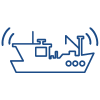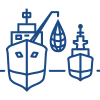Our Map
The Global Fishing Watch map is the first open-access online platform for visualization and analysis of vessel-based human activity at sea. Powered by satellite technology and machine learning, the map merges multiple types of vessel tracking data to provide a view of global human activity at sea, including fishing activity, encounters between vessels, night light vessel detection and vessel presence.
Anyone with an internet connection can access the map to monitor global fishing activity from 2012 to the present for about 70,000 commercial fishing vessels that are responsible for a significant part of global seafood catch. Users can search for vessels, filter activity by flag State or time period, identify port visits and view encounters between vessels. The map also allows anyone to upload and overlay their own data, download reports of activity from custom areas, and save and share workspaces. Free and easy-to-use features offer unprecedented opportunities to increase transparency across the world’s ocean and support the fair and sustainable use of marine resources.
The map supports the understanding, visualization and analysis of global commercial fishing activity by various stakeholders.
- Governments can identify and take action against vessels that are not authorized to fish in their waters or are fishing illegally in protected areas. They can add custom polygons—zone or boundary designations marking a specific area of interest in which to analyze or download data—and generate reports to analyze fishing effort and vessel activity in regulated areas.
- Researchers can study the impacts of fishing on ocean health, identify vulnerable areas, investigate how environmental changes influence fisheries, or evaluate the effectiveness of conservation and fisheries policies.
- NGOs and journalists can identify and investigate suspicious vessels, and advocate for stronger protections across important ecosystems.
- Seafood suppliers and retailers can see where and how fish are caught and ensure they only source from ships that are operating legally and verifiably.
- Fishers can show that they are operating transparently and responsibly, giving them a market advantage by enabling them to sell their catch to customers who demand sustainable, traceable seafood.
How the map works
We analyze automatic identification system and vessel monitoring system data collected from vessels and transmitted through satellite and terrestrial receivers. We apply a fishing detection algorithm to determine “apparent fishing activity” based on changes in vessel speed and direction.

Global
Shows fishing activity and marine traffic of ~70,000 publicly trackable commercial fishing vessels

Near real-time
Regularly updated to show vessel tracks and fishing activity from January 1, 2012 through three days prior to present time

Easy to use
Designed so experts and non-experts can see and assess fishing activity as a glance and track individual vessels over time

Free for everyone
Available to anyone in the world with an internet connection

Fishing effort includes automatic identification system (AIS) data processed by our algorithms to determine when and where vessels are fishing.

Vessel monitoring system (VMS) layers include vessel tracking data collected by our partner governments and processed by our algorithms to determine when and where vessels are fishing.

Vessel encounters include locations where two vessels, a carrier and a fishing vessel, were continuously within 500 meters for at least 2 hours, while at least 10 kilometers from a coastal anchorage, based on AIS data.

Night light vessel detection layer shows vessels at sea that satellites have detected by the light that they emit at night.

Shipping includes AIS data processed by our algorithms to provide a global insight into maritime vessel locations, including shipping and tanker vessels.
Free registration provides full access to our map features, including:
- Vessel identification and tracks.
- Downloadable fishing activity reports.
- Detailed events along vessel tracks, including fishing activity and potential encounters.
- Analysis of specific areas through customized polygons.
- Management and restoration of workspaces.
- All functionality available without a login.
Without a login, you can:
- Review fishing effort by flag, date range or gear type.
- Search for vessels.
- Combine fishing effort layers from various data sources.
- Search activity by date range, bookmark search options, and create animations of vessel activity.
- Overlay jurisdictional boundaries and other reference layers.
- Measure distances between activities.
- Create your own visualizations through sharing of workspaces and screenshots


